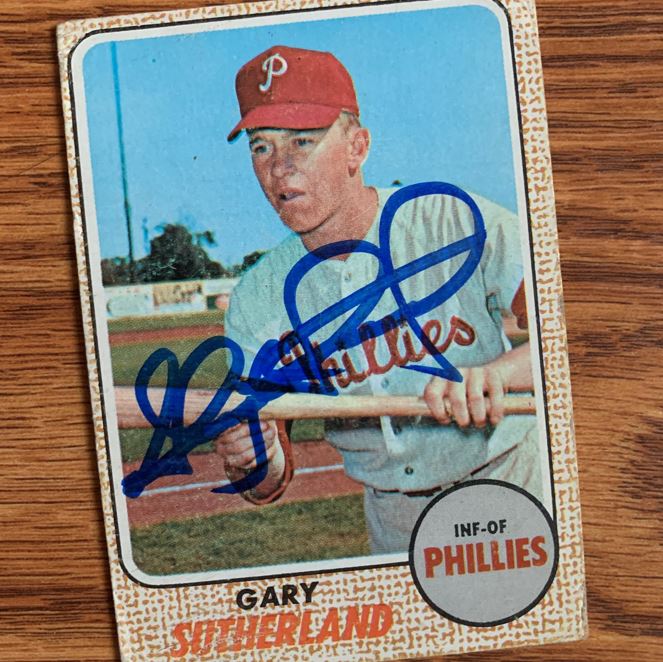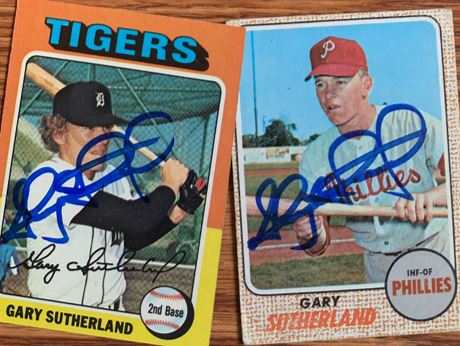
TTM Stats
- Sent: 4/19/2022 | Received: 5/6/2022 | 17 Days
- ’68 Topps, ’75 Topps
- Address: Home (address from Sports Card Forum)
The Story of the Autograph
Gary Sutherland may not be a household name, but his 13-year Major League Baseball (MLB) career stands as a testament to perseverance, versatility, and quiet professionalism. Known for his steady glove, dependable bat, and adaptability, Sutherland was the kind of player every team needed, even if he didn’t always grab the headlines.
Gary Lynn Sutherland was born on September 27, 1944, in Glendale, California. Growing up in Southern California, he developed a love for baseball at an early age. After excelling in high school, Sutherland attended the University of Southern California (USC), one of the most prestigious collegiate baseball programs in the country. His impressive college career caught the attention of professional scouts, and in 1964, he was signed by the Philadelphia Phillies as an amateur free agent.
Sutherland made his MLB debut on September 17, 1967, with the Philadelphia Phillies. Initially used as a utility infielder, he showcased his versatility by playing both second base and shortstop. His smooth fielding and reliable bat earned him a spot on the roster, but he was drafted by the Montreal Expos in 1968, joining the expansion team during its inaugural season.
Sutherland’s time with the Expos marked the beginning of a journeyman career that saw him play for seven different teams, including the Houston Astros, Detroit Tigers, Milwaukee Brewers, San Diego Padres, and St. Louis Cardinals. He found his stride in the early 1970s, particularly during his time with the Tigers. In 1975, Sutherland had his best offensive season, hitting .258 with 12 doubles, six homers, and 39 RBI. Known for his ability to put the ball in play and his knack for clutch hits, he became a reliable presence in Detroit’s infield.
Despite his modest offensive numbers—Sutherland retired with a career .243 batting average, 24 home runs, and 239 RBI—his value was evident in his defensive skills and versatility. He played every infield position and occasionally took on duties in the outfield, always willing to do whatever his team needed.
Sutherland’s career coincided with one of baseball’s most transformative periods—the expansion era. As a member of the Montreal Expos in their inaugural 1969 season, he became part of baseball history, helping establish the sport in Canada. Similarly, Sutherland’s time with the Padres and Brewers reflected the evolving landscape of MLB during the 1970s, as new teams emerged and players like him helped lay the foundation for future success.
After retiring as a player in 1978, Sutherland stayed connected to the sport. He worked in various roles, including scouting and player development, bringing his wealth of knowledge and experience to the next generation of players. Sutherland’s post-playing career was marked by a commitment to nurturing young talent, ensuring that his love for the game continued to have an impact long after his playing days were over.
Gary Sutherland’s career may not have been filled with accolades or All-Star appearances, but his contributions to the game were no less significant. He represented the countless players whose hard work and dedication form the backbone of professional baseball.
As a dependable infielder, a pioneer with expansion teams, and a mentor to future players, Sutherland exemplified the values of perseverance and teamwork. His story is a reminder that baseball’s unsung heroes often leave a lasting legacy that goes beyond the stat sheet.
Gary Sutherland’s life in baseball is a celebration of steady performance, adaptability, and a passion for the game. From his days as a college standout at USC to his role as a journeyman infielder and mentor, Sutherland’s journey reflects the enduring appeal of baseball and the importance of every player in the game’s rich tapestry.
The Score on Gary Sutherland – 7.0


Gary has a loopy signature. In fact, its so loopy that I don’t know that you can really make sense of what is what. You can kind of see the “G” and the “y” in there, and I assume the loops at the end are the “t” or “l” and then the “d” at the end. Either way he did a really good job on these. Especially that ’68. I don’t have many of those signed so that’s a nice one for me.
Thanks Mr. Sutherland! I’m giving this return a 7 overall.
This is my third successful return from him. To see the other successful return, check out these posts:

>>> READ MORE ABOUT MY AUTOGRAPH SCORING SYSTEM <<<
Thanks for visiting BravestarrCards.com: Card Collecting and TTM Autographs.
Information gathered using Wikipedia and Baseball Reference.